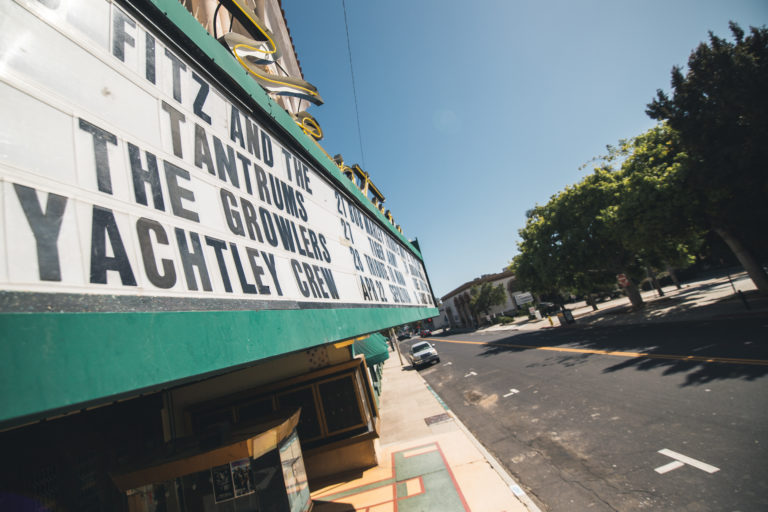
Alondra Sierra
Features Editor
It was no more than a year and a half ago when current owner Jennifer Housch took over The Mercury Lounge, continuing the dive bar’s reputation as a mature place to grab a drink, hang out with friends, and listen to whatever live music the night had in store. Behind the red door in Old Town Goleta, local and touring artists performed free of charge — be it surf rock cover bands, small-town DJs, hardcore punk groups, or international songwriters.
But like all things COVID-19 has hurt, Housch closed her doors when she was just steadying her business. “Basically we went from a steady income to nothing. As soon as you close your doors, that’s it,” Housch said.
Music venues sit at the tail end of Governor Gavin Newsom’s plan to reopen California. Left in the dark, local independent music venues are waiting for a sign of what is to come in their future.
As a bar, The Mercury Lounge doesn’t have many options to make up for its loss of income. Housch applied to every small business and oddball loans and grants she could find, but many turned her down. Employees can’t work from home, so they were laid off; federal aid like the Payroll Protection Program was futile in her case. To get by, she’s been selling merchandise, closed bottles, and cans on the side.
Over in downtown Santa Barbara, venues like The Red Piano are trying out pay-what-you-can live stream performances while SOhO Restaurant and Music Club have set up a rewards program where people can purchase tickets and bundles that can be used once the venue opens again.
After its last show on March 13, the mid-sized venue in the heart of Santa Barbara furloughed all its employees and closed its doors following state orders. Since then, SOhO has been creating new ways to support their space, like auctioning off old instruments and memorabilia signed by artists like Depeche Mode’s Martin Gore and Jeff Bridges.
“We’re trying to take in whatever we can … whatever assets we can turn into income,” said SOhO’s floor manager Alec Beloin.
It may be months before music venues re-open, and even then it’s unclear what kind of restrictions entertainment venues must follow to prevent the spread of the virus in close spaces.
Think about it: at theaters, stadiums, or other massive venues, hundreds of guests gather and sit side by side. At standing-only venues, people dance, sweat, and breathe en masse to the music and if it’s an intimate show, the artist will also be singing, breathing, sweating in close proximity to the crowd. It makes sense that venues are considered high-risk environments, but it also means that once music venues are back in business, they may not be entirely back in business.
A venue like SOhO with a capacity of around 400 people per night might be forced to cut down significantly on how many are allowed to be in the room at once.
“A venue like this relies on nights when there’s 300 to 400 people here eating and drinking and having a good time listening to music. It doesn’t really function on nights when there’s only 50 people here,” Beloin said. “But if there’s a situation where there’s only going to be allowed 50 people here for the next couple months, I don’t know how that will be financially viable.”
Housch, whose landowner is understanding of her situation, feels the same way. “Unless we open up and have 100 percent capacity again, I’m not going to be able to pay my rent,” she said in an interview with The Bottom Line.
Despite the setbacks, Santa Barbara isn’t ignoring its arts and culture scene. Last week, the Santa Barbara county’s Arts Commission announced that it’ll be giving out over $75,000 in COVID-19 relief grants to nonprofit organizations that promote arts and culture. It’s a move that many counties are making to lend a hand to an industry that gives back to the local economy. But independent music venues, of course, are left out of the grant initiative.
For local artists, losing another music venue would only do more harm to Santa Barbara’s live music scene. Josh Kass, drummer for Santa Barbara band Goldy, says that it’s tough as it is for young bands and artists in the area when most venues are pay-to-play. He remembers the good ol’ days when FUNZONE was around, a DIY space cradled by the East Beach Batting Cages, unrestricted by age or experience.
“Friends didn’t have to worry about affording a ticket or paying a cover or being under 21 as well, which made the shows so much more inviting and exciting,” said Kass. The space permanently closed down in 2017 (though the name continues to promote safe and inclusive DIY events in the area), leaving one less established venue in Santa Barbara.
Venues are fighting for survival everywhere. Shortly after COVID-19 closures, over a thousand independent music venues across the country — SOhO being one of them — joined arms to form The National Independent Venue Association. Together, they’re sharing modes of sustainability and urging legislators to financially assist the industry so those struggling may come to see another day.
Housch has received offers from patrons wanting to help by buying future drink tickets, but for a business whose future is up in the air, she doesn’t feel comfortable accepting.
“I know people want to help but I don’t feel right taking money for something that later on I might not be able to honor,” she said. Instead, Housch hopes people can contact local representatives to help their local venues.
It may be a while before the pit opens back up, before the buzz and clamor of music venues returns, and before audiences can cheer on their local artists in the same room. Until then, the fight continues to keep local music alive.










